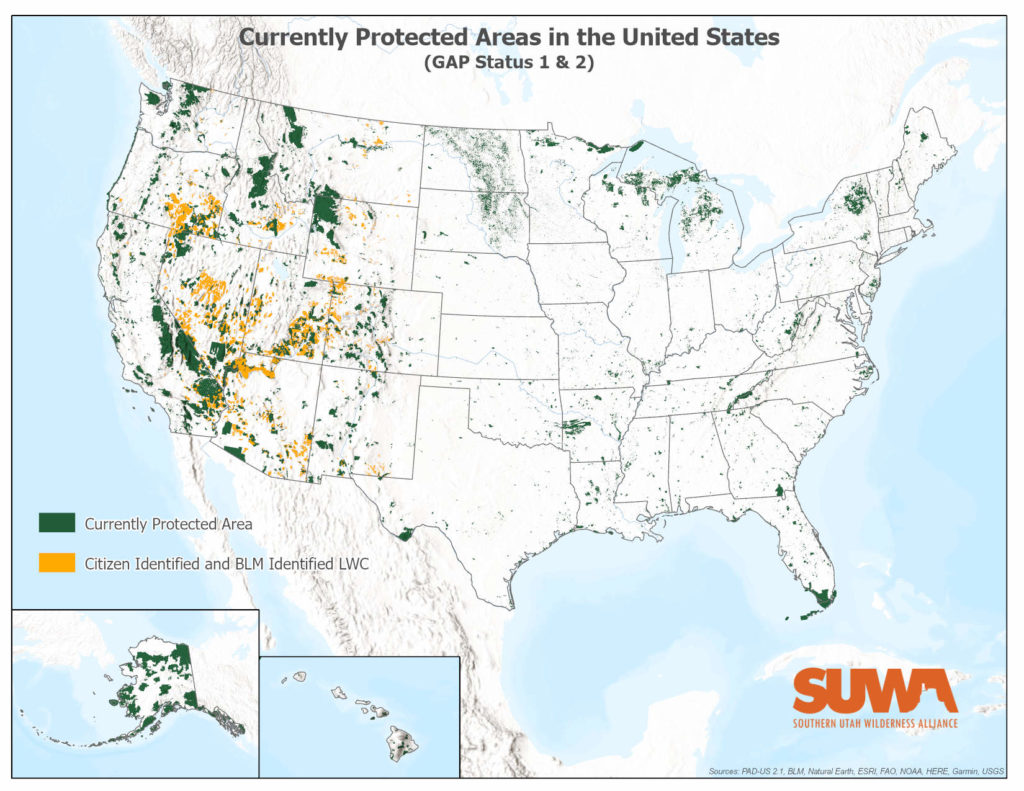30 x 30 refers to the goal of protecting 30% of America’s (and the world’s) land and water by the year 2030. It is an interim step towards the larger goal of protecting 50% by the year 2050. These goals have been recommended by scientists as the means of addressing two intersecting planetary crisis: the Collapse of Nature and Climate Change.
The Sixth Extinction
The Collapse of Nature is a reference to the sixth mass extinction which is currently underway – think the death of the dinosaurs. The difference today is this one is human caused. Chief among the causes are loss of habitat (i.e., wild places) and climate change. As illustrated by the example of the once dominant dinosaurs, this shrinking of the web of life on Earth is a direct threat to human well-being. The goal of 30 x 30 addresses this concern by preserving wild lands and thereby homes for wildlife.
A Climate in Crisis
Climate change is a familiar concept. It’s the increased warming of Earth due to excess emissions of greenhouse gases. Scientists say that in order to avoid catastrophic consequences we need to keep the global temperature increase as measured since the beginning of the industrial revolution to below 1.5 degrees Celsius. The current measurement is 1 degree and rising. Once gases are in the atmosphere they remain there a long time; NASA estimates 300 – 1,000 years. To successfully address climate change we need to dramatically reduce the emission of greenhouse gasses and draw down the carbon in the atmosphere via sequestration in plants and soils. 30 x 30 makes a crucial contribution by precluding extraction of carbon fuels and securing sequestration via protection of natural places.
30 x 30 also plays an important role in environmental justice. It is well documented that indigenous poor and minority communities are harmed first and worst by climate change. This is true too regarding the collapse of nature: the consequences will arrive first for the most vulnerable humans. Justice also applies to the wild world whose creatures suffer. People, creatures, air, lands, and waters are essential elements of a just global community.
Protecting Wild Landscapes: A Lifeline for Our Future
The United States has approximately 2.4 billion acres of land. Twelve percent has been adequately protected, which equals about 293 million acres. This leaves roughly 438 million additional acres in need of protection (America’s Red Rock Wilderness Act covers 1.5% of that total).
The Bureau of Land Management has a unique tool available to it to advance the 30 x 30 cause: the establishment of Wilderness Study Areas (WSAs) as authorized by Section 202 of the Federal Land Policy and Management Act. The agency has been gradually identifying lands with wilderness character (LWC) as have citizens’ groups across the West (see map below). If these lands were designated as Wilderness Study Areas it would be a huge advance toward the nation’s 30 x 30 goals.
The U.S. Geographical Survey’s Gap Analysis Project’s (GAP) Protected Areas Database has four levels of protection. GAP 1 and 2 are deemed to possess natural conditions of sufficient health and permanence to advance the 30 x 30 objectives of protecting habitat and sustaining carbon sequestration. The U.S. has one level of protection that matches GAP 1: designated wilderness. There are multiple levels of protection which meet the GAP 2 standard of having permanent protection and a mandated management plan in operation to maintain a primarily natural state. These include things such as national parks and monuments, conservation easements, and state, local, tribal, or privately owned nature preserves. Click here to view an interactive map of GAP 1 and 2 designations in Utah.
Some argue that elements of GAP 3, which allows for some extractive activities (“low intensity” logging and “isolated” mining), should also be considered as sufficient to attain 30 x30 goals. However, more protective and long-lasting conservation designations are clearly preferable.
For more on 30 x 30 and where Utah’s wilderness lands fit in, see The Role of America’s Red Rock Wilderness Act in Protecting Biodiversity and Mitigating the Climate Crisis.


